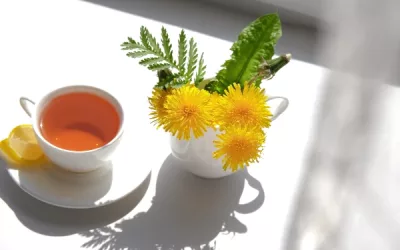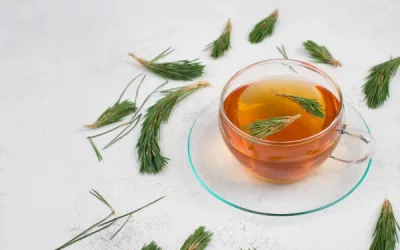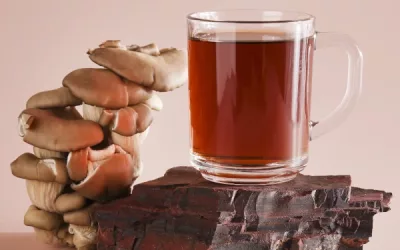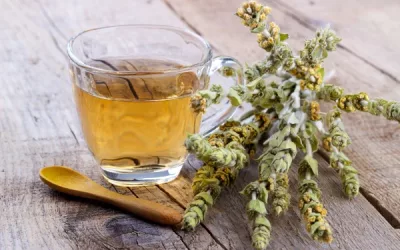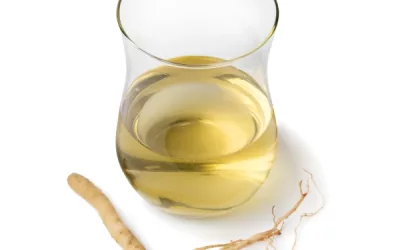Have you ever sipped a warm cup of cardamom tea and wondered about the secrets behind its soothing aroma? This fragrant brew, beloved across cultures, is more than just a delightful beverage; it’s a historical emblem of hospitality and health. As we explore the origins, recipes, and myriad benefits of cardamom tea, you’ll discover why it deserves a place in your daily routine. Buckle up for a journey into the heart of cardamom tea, where taste meets wellness!
Table of Content
- What is cardamom tea and its cultural significance?
- How can you prepare the perfect cardamom tea?
- Can cardamom tea be served cold?
- What spices can be added to cardamom tea?
- How many calories are in cardamom tea?
- How does the caloric content change with added ingredients?
- What are some low-calorie alternatives for cardamom tea?
- How does cardamom tea compare calorically to other herbal teas?
- Can I use cardamom powder instead of pods for tea?
- What are the flavour differences between cardamom pods and powder?
- Is cardamom powder easier to use than pods?
- How does the nutritional content differ between the two forms?
- What are some variations of cardamom tea?
- Conclusion
What is cardamom tea and its cultural significance?
Cardamom tea is a fragrant and spicy beverage made by infusing tea leaves and cardamom pods in hot water. This delightful drink holds a significant place in various cultures, particularly in South Asia and the Middle East. Its unique flavour profile and numerous health benefits have made it a beloved choice for many.
The origins of cardamom tea trace back to ancient civilisations where cardamom itself was highly valued not just as a spice but also as a medicinal herb. This tea has been an integral part of social gatherings, festivals, and daily routines across different cultures, symbolising warmth and hospitality.
What are the origins of cardamom tea?
Cardamom tea’s roots can be found in ancient India, where cardamom has been used for centuries. The spice was a crucial ingredient in Ayurvedic medicine due to its digestive and aromatic properties. It later spread to the Middle East and other parts of Asia, becoming a staple in their culinary traditions.
- Ancient origins in India
- Used in Ayurvedic medicine
- Spread to the Middle East and Asia
- Integral part of cultural traditions
In India, cardamom tea is often enjoyed as part of the daily chai ritual. In the Middle East, it is frequently blended with coffee and tea to enhance the flavour and aroma, turning an ordinary beverage into a luxurious experience. The diverse ways it is prepared and served highlight its cultural significance.
How is cardamom tea traditionally served in different cultures?
Cardamom tea is served in various ways across different regions, reflecting each culture’s unique traditions and preferences. In India, it is typically prepared with milk and sugar, creating a creamy and sweet concoction. In contrast, Middle Eastern cultures often serve it without milk but with a touch of sweetness from honey or sugar.
- Indian chai with milk and sugar
- Middle Eastern tea with honey
- Served hot or cold
- Often accompanied by pastries or snacks
The serving style varies, but the essence remains the same – cardamom tea is a symbol of hospitality. In many cultures, offering cardamom tea to guests signifies warmth and welcome. Whether it’s a casual visit from a friend or a significant celebration, this tea plays a crucial role in social interactions.
Cardamom tea is more than just a beverage; it’s a part of various social rituals and traditions. In India, it is often served during family gatherings and festivals, symbolising togetherness and joy. The Middle East has a long tradition of serving spiced tea during important ceremonies and everyday hospitality.
- Family gatherings and festivals
- Ceremonial rituals
- Daily hospitality customs
- Symbol of togetherness
These rituals highlight the tea’s importance in fostering social bonds. The act of preparing and sharing cardamom tea is a gesture of goodwill and friendship, demonstrating the deep-rooted cultural significance of this aromatic drink.
One fascinating historical story involves the ancient Indian practice of offering cardamom tea to royal guests. During the Mughal era, cardamom tea was a royal treat, and its preparation was an elaborate affair. The Mughals believed that cardamom tea not only pleased the palate but also had calming effects, making it the perfect beverage for esteemed guests.
How can you prepare the perfect cardamom tea?
Preparing the perfect cup of cardamom tea is easier than you think. The aroma of cardamom fills the air, instantly making you feel relaxed. It’s a delightful blend of spices and warmth, perfect for any time of the day. Here’s a simple guide to get you started.
First, gather your ingredients:
- 2 cups of water
- 4 green cardamom pods
- 1 black tea bag or 1 teaspoon of loose black tea
- 1-2 teaspoons of sugar or honey (optional)
- 1/2 cup of milk (optional)
- A small piece of ginger (optional)
Here’s a step-by-step process:
- Boil Water: In a saucepan, bring 2 cups of water to a boil.
- Add Cardamom: Crush the cardamom pods slightly to release their flavour and add them to the boiling water.
- Add Tea: After a minute, add the black tea. If you’re using a tea bag, just drop it in.
- Sweeten: Stir in sugar or honey as per your taste.
- Simmer: Let the mixture simmer for 3-4 minutes.
- Add Milk: Pour in the milk if you prefer a creamier tea, and let it simmer for another minute.
- Strain and Serve: Strain the tea into cups and enjoy!
Comparison of different cardamom tea recipes
Below is a table comparing various cardamom tea recipes. This will help you decide which variation suits your preferences. Each recipe has unique ingredients and preparation times, so you can pick one based on your mood and available time.
| Recipe Name | Ingredients | Preparation Time | Serving Size | Unique Features |
|---|---|---|---|---|
| Classic Cardamom Tea | Water, Green Cardamom Pods, Black Tea, Sugar, Milk | 8 minutes | 2 cups | Basic, traditional flavour |
| Cardamom Ginger Tea | Water, Green Cardamom Pods, Black Tea, Ginger, Honey | 10 minutes | 2 cups | Spicy and warming |
| Masala Cardamom Tea | Water, Green Cardamom Pods, Black Tea, Cinnamon, Cloves, Ginger, Milk, Sugar | 12 minutes | 3 cups | Complex spice blend |
| Cardamom Mint Tea | Water, Green Cardamom Pods, Fresh Mint Leaves, Green Tea, Honey | 8 minutes | 2 cups | Refreshing and light |
| Cardamom Turmeric Tea | Water, Green Cardamom Pods, Black Tea, Ground Turmeric, Black Pepper, Honey | 10 minutes | 2 cups | Anti-inflammatory properties |
| Cardamom Rose Tea | Water, Green Cardamom Pods, Black Tea, Dried Rose Petals, Honey, Milk | 12 minutes | 2 cups | Floral and aromatic |
| Cardamom Lemon Tea | Water, Green Cardamom Pods, Black Tea, Lemon Juice, Honey | 9 minutes | 2 cups | Citrusy and invigorating |
This table provides a quick overview, helping you to choose a recipe that matches your taste and time constraints. Each variation offers a unique twist to the traditional cardamom tea, making it easy to experiment and find your favourite.
What are the health benefits of cardamom tea?
Cardamom tea isn’t just tasty; it’s also packed with health benefits. Here’s a closer look at why you might want to include it in your daily routine:
- Digestive Aid: Cardamom tea helps to improve digestion and can relieve nausea.
- Antioxidants: It contains antioxidants that protect cells from damage.
- Anti-inflammatory: Cardamom has anti-inflammatory properties that can help reduce swelling.
- Oral Health: The tea promotes oral health by fighting bad breath and cavities.
- Detoxification: It supports detoxification by stimulating kidney function.
Drinking cardamom tea can contribute to your overall well-being. It’s a simple way to incorporate beneficial properties into your diet.
How can you customise cardamom tea to suit your taste?
Customising cardamom tea is easy and fun. You can experiment with various ingredients to create a blend that suits your palate. Here are some ideas:
- Spices: Add cinnamon, cloves, or black pepper for a spicier flavour.
- Sweeteners: Use honey, agave syrup, or even maple syrup instead of sugar.
- Herbs: Fresh mint or basil can add a refreshing twist.
- Milk Alternatives: Try coconut milk, almond milk, or oat milk for a different texture.
- Citrus: Lemon or orange zest can provide a zesty kick.
Experimenting with these variations can make each cup of cardamom tea a new experience. You’ll never get bored of the same flavour.
In ancient India, cardamom tea was more than just a beverage. It was a symbol of hospitality. Hosts would serve this aromatic tea to guests as a sign of respect and warmth. Over time, spiced teas became an integral part of Indian culture, each region adding its unique twist.
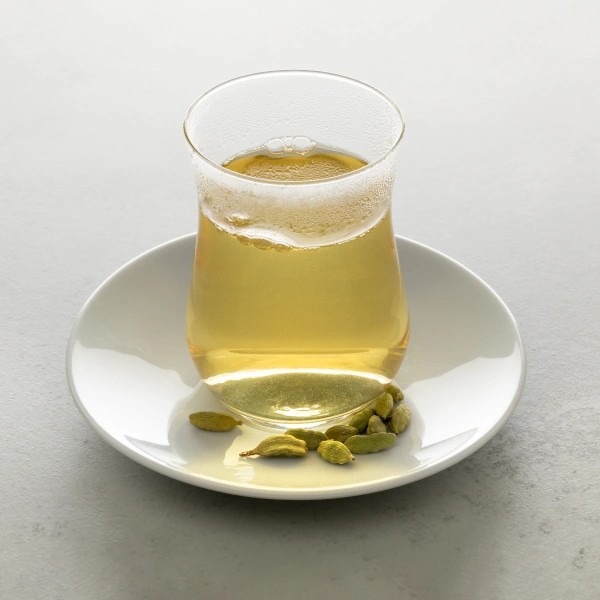
Can cardamom tea be served cold?
Absolutely, cardamom tea can be served cold, and it’s like a cool breeze on a summer’s day – refreshing and delightful. In fact, this versatile beverage can be enjoyed hot or cold, making it a staple in your tea collection all year round.
But hey, let’s not stop there. Imagine sipping on a cold glass of iced cardamom tea on a hot afternoon. Heavenly, right? It’s not only thirst-quenching but also a flavour explosion you didn’t know you needed. The aroma of cardamom, a dash of added ingredients, and a chill factor make it a global hit, so why not let it jazz up your beverages?
What are the best methods to serve cardamom tea cold?
Preparing iced cardamom tea is way easier than you think. Consider it your go-to craft, especially when you’re aiming to impress without stressing. Here’s how:
- Brew a strong batch of cardamom tea with double the usual amount of tea leaves or bags to ensure the flavour stands out when chilled.
- Let it cool to room temperature before refrigerating it for a few hours. You don’t want to be fainting over a hot brew.
- Add ice cubes made from cardamom tea, avoiding dilute flavour issues.
- Sweeten it while it’s hot if needed, using honey, sugar, or any sweetener of your choice.
Look at it as your DIY iced cardamom tea – brewed strong, sweetened to your liking, and perfectly chilled. With few simple steps, you get a satisfying cold beverage ready to be served.
What flavour enhancements can be added to iced cardamom tea?
To make your iced cardamom tea the talk of the town, adding unique flavours can elevate the drink to the next level. Here’s where the fun happens:
- Fresh mint leaves for a cool, crisp twist.
- Lemon slices for that tangy zing.
- A hint of vanilla extract for a soothing undertone.
- Cinnamon sticks to complement the cardamom spiciness.
- Fresh fruit slices like orange or berries for a fruity explosion.
These enhancements aren’t just about flavour; they’re also about giving your tea a visual appeal that says, “Drink me!” Whether you’re aiming for a citrusy delight or a minty freshness, your cardamom tea, cold or iced, will never be the same again.
How can cardamom tea be presented attractively?
Presentation matters, especially when you’re playing host or just indulging yourself. Making your iced cardamom tea look as good as it tastes is simpler than you’d imagine:
- Serve in tall, clear glasses to showcase the tea’s inviting colour.
- Garnish with a sprig of mint or a cinnamon stick hung over the rim.
- Add colourful fruit slices inside the glass for a visually appealing contrast.
- Use ornate, patterned ice cubes for a touch of sophistication.
- A straw, maybe a fancy biodegradable one, and an umbrella stick can give it a tropical vibe.
Even at its core, cardamom tea is spectacular, but when dressed up a bit, it becomes the star of your table. An elegant presentation can elevate the simplest of recipes into something truly remarkable.
Do you know the first recorded instance of iced tea being served? It takes us back to the 1904 World’s Fair in St. Louis. Richard Blechynden, faced with a lack of interest in hot tea due to scorching weather, decided to pour the tea over ice to attract visitors. It was a hit! Just as iced tea enjoyed its moment of glory then, your perfect glass of iced cardamom tea has every potential to steal the spotlight today.
What spices can be added to cardamom tea?
Let’s be honest; cardamom tea is already a superstar in the world of beverages. But even the best can get a boost now and then. Enter the Spice Avengers: cinnamon, ginger, cloves, black pepper, and nutmeg! No need to assemble them—they’re probably already in your spice rack, waiting for their moment of glory. Want to jazz up your cardamom tea? Let’s dive into how these spices can play a part.
Cinnamon is like that reliable friend who always adds a touch of warmth and sweetness to the party without stealing the spotlight. Ginger, on the other hand, is the party-starter with a zingy twist, exciting your taste buds from the first sip. Cloves add a depth and complexity worthy of a classical concert, while black pepper spices things up with a peppery kick that’s hard to resist. And nutmeg? It’s the smooth talker, rounding out the flavours and making everything meld together like a well-rehearsed band.
Each of these spices brings something unique to the table, and when mixed with cardamom tea, the result is nothing short of magical.
How does cinnamon enhance the flavour of cardamom tea?
Cinnamon and cardamom are a match made in tea heaven. Why? Because cinnamon adds a warmth that complements the citrusy, floral notes of cardamom, making your cup of tea feel like a cosy hug on a rainy day. It’s not just about flavour; cinnamon has a way of making your tea aroma irresistible too.
- Adds warmth and sweetness
- Boosts the tea’s aroma
- Balances cardamom’s citrusy notes
- Elevates the overall taste profile
- Makes your tea aesthetically pleasing with its reddish hues
When you sip that first cup with a stick of cinnamon, it’s like wrapping yourself in a warm blanket. Cinnamon doesn’t scream for attention; it provides a subtle yet impactful change that makes your tea time luxurious and comforting.
What are the benefits of adding ginger to cardamom tea?
Ginger might look unassuming, but this root packs a punch. Adding ginger to cardamom tea not only elevates the taste but also gives your health a boost. It’s the Batman and Robin of tea blends!
- Adds a spicy zing to your tea
- Aids in digestion
- Has anti-inflammatory properties
- Helps combat nausea
- Boosts the immune system
With ginger, you don’t just get a tea that tastes fantastic; you get a drink that’s like having a mini health spa session. It’s perfect for those chilly mornings when you need a bit of a kick to get you going, or when you’re feeling under the weather.
Can black pepper be used in cardamom tea?
Black pepper in tea? Sounds odd, but trust your taste buds; they know what’s up. Adding black pepper to cardamom tea gives it that something-something— a peppery kick that surprises your senses and leaves you craving more.
- Adds a subtle spicy kick
- Enhances the bioavailability of nutrients
- Aids in digestion
- Has antioxidant properties
- Boosts metabolism
Your cardamom tea will go from basic to bold with just a pinch. It’s surprising but exhilarating, much like that one friend who always brings spontaneity and excitement to your otherwise predictable life.
Imagine living in the 9th century in the lush green landscapes of Southern India, where cardamom was so prized it was often used as a currency. Yet it wasn’t until cardamom found its way to the bustling spice markets of ancient Rome that it really took off.
The Romans loved it for its aroma and its supposed health benefits, often using it in rituals and herbal concoctions. Mix that ancient legacy with these modern-day spices, and you’ve got yourself a cup of tea steeped in history and brimming with contemporary flair.
How many calories are in cardamom tea?
Alright, you’re wondering how many little calories lurk in your cup of cardamom goodness, aren’t you? Well, here’s the scoop: cardamom tea, in its purest, no-frills form, is practically a dieter’s dream with barely any calories to worry about. But, like any delicious treat, things get a bit more calorific when you start adding all your favourite extras.
Let’s start with the basics. A straightforward cup of cardamom tea, brewed with just water and the aromatic seeds, dances around a mere 2 calories. Yes, you heard it right, just 2! It’s like having a calorie-free ticket to Flavourtown.
But, what if you’re a milk-and-sugar kind of person? Well, brace yourself. Adding a splash of milk could set you back about 30-50 calories, depending on your generosity. Toss in a teaspoon of sugar, and you’re looking at another 16 calories. Not catastrophic for a cup of deliciousness, but it’s definitely inching up.
How does the caloric content change with added ingredients?
Now, let’s get down to the nitty-gritty of how those calories multiply when you start getting creative with your cardamom tea. Spoiler alert: it’s a slippery slope.
- Basic Recipe:
- Simple brew with water and cardamom: around 2 calories.
- Add Milk:
- Whole milk: approximately 40-50 calories per splash.
- Add Sugar:
- One teaspoon of sugar: 16 calories.
- Flavour Variations:
- Adding honey: roughly 21 calories per teaspoon.
- Adding almond milk: around 10 calories per splash.
- Serving Size Impact:
- Bigger cup size, more added ingredients = more calories.
So, if you’re the kind of person who loves to turn a simple brew into a lavish dessert, it’s easy to understand how a harmless cup of tea can creep into “guilty pleasure” territory. Keep a close eye on those additions, or you’ll find your supposed healthy sip closer to an indulgence.
What are some low-calorie alternatives for cardamom tea?
Fear not, calorie-conscious drinkers, you can keep savouring that spice without piling on the pounds. Here are some virtually guilt-free twists to keep your tea tasty but lean.
- Stevia instead of Sugar:
- Zero-calorie sweetening without the aftertaste.
- Skimmed or Plant-based Milk:
- Swap whole milk for unsweetened almond milk or skimmed milk, which are substantially lower in calories.
- Cinnamon Addition:
- Just a sprinkle for some added flavour without extra calories.
- Vanilla Essence:
- A few drops can offer a sweet lift without the calorific consequences.
- Lemon Juice:
- A dash of lemon for a zesty twist, practically calorie-free.
By tweaking these ingredients, you can drink to your heart’s content without any remorse. Who says you can’t enjoy a fulfilling cup without calorie chaos?
How does cardamom tea compare calorically to other herbal teas?
Alright, now you’re probably curious how this spice gem stacks up against other teas in the calorie competition.
- Chamomile Tea:
- Similar to cardamom, chamomile tea runs at a cool 2 calories per cup.
- Peppermint Tea:
- Matching chamomile and cardamom’s efficiency, peppermint tea is also about 2 calories per cup.
- Ginger Tea:
- It keeps the table level, cruising just around 2 calories.
- Green Tea:
- Lightly brewed, it’s around 2-3 calories a cup.
- Masala Chai:
- Loaded with spice and everything nice, but about 150 calories with milk and sugar.
Without the fancy extras, cardamom tea, like its herbal counterparts, is harmless and light. However, when compared to something like masala chai, cardamom tea is a featherweight.
One day, a revered poet named Mirza Ghalib, who frequented the bustling streets of Delhi in the 19th century, was known to indulge in the many flavours of Indian tea. He favoured a simple, spice-laden brew, often with cardamom, praising its ability to clear the mind and invigorate the spirit.
It’s said that he worked his way through a creative block with a hot cup of cardamom tea, composing some of his most memorable ghazals thereafter. His love for simple, aromatic beverages reminds us that sometimes, the heart desires flavours over frills.
Can I use cardamom powder instead of pods for tea?
Sure, you can use cardamom powder instead of pods for tea, but it’s not entirely the same experience. It’s like comparing an original masterpiece to a print. While both have their merits, they serve slightly different tastes, textures, and purposes.
Using cardamom powder just makes things quick and easy—like the fast food version of tea preparation. On the other hand, cardamom pods offer a richer, more aromatic experience. Think of it as the slow-cooked meal that pulls all the flavours together in one cohesive bite. Each form has its own quirks, and picking one over the other depends on what you value most in your tea.
What are the flavour differences between cardamom pods and powder?
When it comes to flavour, cardamom pods and powder aren’t exactly twins.
- Cardamom pods:
- Offer a more robust, full-bodied flavour.
- Make your tea feel a touch more exotic and aromatic.
- Release oils slowly, giving you sustained flavour.
- Provide a natural, subtle sweetness.
- Cardamom powder:
- More intense, like a single musical note rather than a symphony.
- Can sometimes taste slightly bitter if overused.
- Disperses quickly throughout the tea.
- Offers convenience, especially if you’re in a rush.
In a nutshell, pods are the slow burners that gradually fill your senses, while powder is the instant hit. Both have their attributes, but the pods’ gradual release generally wins in terms of pure flavour immersion.
Is cardamom powder easier to use than pods?
When it comes to ease of use, cardamom powder easily snags the medal. Let’s see why:
- Measures easily: No fussing with cracking open pods and fishing out seeds.
- Blends well: Mixes seamlessly into your tea without any lumps.
- Time saver: No need to simmer for ages to get the flavour.
- Storage-friendly: Occupies less space and often comes in handy, shaker-type containers.
But, and it’s a big but, just because it’s easier doesn’t mean it’s always better. While the powder offers instant gratification, it lacks the nuanced, layered flavour profile that the pods give. It’s like microwaving a meal versus slow-cooking it—sure, both feed you, but one is an experience.
How does the nutritional content differ between the two forms?
Nutritionally, you’re not getting off the ride yet. Cardamom powder and pods do have subtle differences.
- Antioxidants:
- Both forms pack antioxidants, but pods have a slightly higher concentration.
- Essential oils:
- Pods are rich in essential oils, which can dissipate when ground into powder.
- Caloric content:
- Minimal difference, but the whole pods might offer a slight edge in dietary fibre.
- Shelf life:
- Powder has a shorter shelf life due to faster degradation of nutrients once ground.
In essence, pods offer the nutritional edge with a bit more fibre and essential oils, especially if you don’t mind the hassle of cracking them open.
As a related fun fact, in India, cardamom (or “elaichi”) has been used for centuries not just in tea but as a digestive aid. It’s also part of chai, which dates back to over 5,000 years when it was a healing Ayurvedic drink.
So whether you go for the quick hit of flavour from powder or the slow, aromatic build-up of pods, you’re treading in the footsteps of history with each sip.
What are some variations of cardamom tea?
You’ll be thrilled to know that cardamom tea isn’t a one-trick pony. It comes in numerous variations that tickle taste buds from different corners of the world. From the spicy masala chai to the creamy Kashmiri chai, the refreshing Thai tea to diverse herbal blends, there’s always a sippable surprise waiting to be discovered.
Welcome to the world of cardamom tea variations. These aren’t just run-of-the-mill recipes; they’re liquid symphonies drawing in a plethora of culture and health benefits. Each type offers its own unique take on the humble cardamom, ensuring that you never get bored and your health meter hits the green zone. Grab your teapot, because we’re diving into a potpourri of flavours.
What is masala chai and how does it differ from regular cardamom tea?
Masala chai is basically your regular cardamom tea that hit the gym—spiced up, layered, and ready to rock your taste buds. Unlike the simple cardamom tea, which is all about cardamom and water (maybe milk if you’re fancy), masala chai throws in an inviting spice party. Think of it as a tea version of a Bollywood dance number.
- Spices Galore: Masala chai includes a combo of cardamom, cinnamon, cloves, ginger, and black pepper.
- Base Tea: Black tea is the usual suspect, providing a sturdy base to build the flavour tower.
- Milk and Sugar: Full-fat milk (or whatever dairy-free option floats your boat) and sugar to taste are added.
- Aromatic: The spices make it aromatic and invigorating from the very first sip.
- Comfort Drink: It’s like a warm hug in a mug, perfect for those chilly mornings or afternoons.
Masala chai isn’t just tea; it’s an experience. The blend of spices adds depth and warmth, making it the perfect drink for when you crave something more exciting than your standard coffee. So, chuck that boring bag of tea and treat yourself to the spicy splendor of masala chai.
How is Kashmiri chai prepared with cardamom?
Kashmiri chai, or Noon Chai, takes cardamom tea and adds that luxurious touch you didn’t know you needed. This isn’t your slapdash cup of tea. It demands time, love, and some specific goodies to get it just right.
- Green Tea Leaves: The base here is green tea, not black.
- Cardamom and Sodium Bicarbonate: The cardamom stays, but you’ll also toss in some baking soda.
- Distinctive Pink Colour: The sodium bicarbonate helps achieve that signature pink hue.
- Milk and Salt: Forget sugar; salt is what you need here for that authentic taste.
- Taste and Texture: Creamy, slightly salty, and utterly unique.
It’s an exercise in patience, especially the continuous boiling and stirring to get that noteworthy colour and taste. But, boy, is it worth it. This pink tea isn’t just a drink; it’s a ceremony, a soothing cultural tradition that feels like a warm blanket around your busy day.
What unique ingredients are used in Thai cardamom tea?
Fancy something exotic? Enter Thai tea, the vibrant vacation your taste buds didn’t know they needed. Cardamom tea in a tropical suit, if you will. What sets Thai cardamom tea apart are the strikingly different ingredients that make it a sweet, creamy delight.
- Black Tea and Cardamom: Obvious starting points, but the rest is a rollercoaster.
- Star Anise: This spice adds a licorice-like twist.
- Tamarind and Vanilla: For a tangy and aromatic kick.
- Condensed Milk and Sugar: Sweetness overload with creamy depths.
- Evaporated Milk: Optional but luxurious; adds more creaminess to the brew.
Imagine sipping this vibrant drink while lounging by a sunny window or after a spicy Thai meal. The star anise and tamarind give it that unexpected zing, while the condensed milk brings it all back to creamy comfort. Thai cardamom tea is a well-balanced dichotomy of exhilarating and comforting.
Back in the 1500s, in the Persian Empire, traders were said to enjoy their own form of spiced tea. They would blend various exotic spices like cardamom and saffron into their tea, enjoying it as both a luxury and medicinal brew.
This ancient habit laid the groundwork for today’s cultural tea spectacles. So, next time you sip on a fancy cardamom variation, remember, you’re partaking in a legacy that’s been brewing for centuries.
Conclusion
As I reflect on the rich tapestry that is cardamom tea, I find myself truly captivated by its multifaceted nature. This delightful beverage not only boasts a storied history steeped in cultural significance but also promises an array of tantalising health benefits.
Our journey through the origins, preparation methods, and complementary spices reveals how cardamom tea can easily adapt to suit any palate or occasion—be it a comforting cup on a chilly day or an invigorating iced variation during warmer months.
The implications of embracing cardamom tea extend beyond just a personal indulgence; this beverage invites us to engage with traditions that have spanned generations and geographies.
Understanding its potential benefits—from aiding digestion to enhancing respiratory health—urges us to consider what we choose to consume and the impact it has on our wellbeing. Moreover, the versatility of cardamom tea presents an exciting opportunity for culinary exploration.
Whether it’s experimenting with variations like masala chai or refreshing iced blends, there is room for creativity and personal expression with each sip.
As we continue to uncover the wonders of cardamom tea, I encourage you to delve deeper into the flavours and health benefits that it offers. Perhaps you might explore the fusion of spices or compare cardamom powder with its pods in your brews.
In this ever-evolving culinary landscape, the question remains: how will you make cardamom tea your own? Embrace the journey and let each cup not only refresh your senses but also connect you with the vast heritage this exquisite beverage embodies.
Resources
- Effect of cardamom consumption on inflammation and blood pressure in adults: A systematic review and meta‐analysis of randomized clinical trials
- The favorable impacts of cardamom on related complications of diabetes
- The effect of cardamom supplementation on serum lipids, glycemic indices and blood pressure in overweight and obese pre-diabetic women: a randomized controlled trial
- Anti-inflammatory, Antioxidant, and Gastro-Protective Actions of Cardamom
- 10 Health Benefits of Cardamom, Backed by Science
- Study reveals the health and dietary benefits of consuming cardamom


